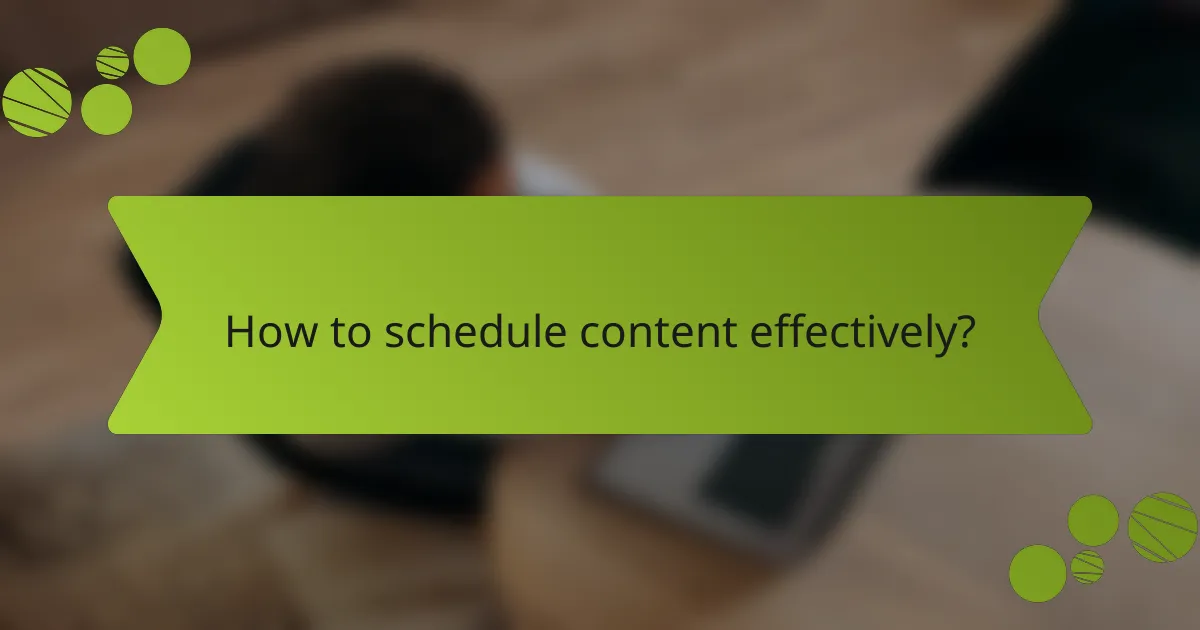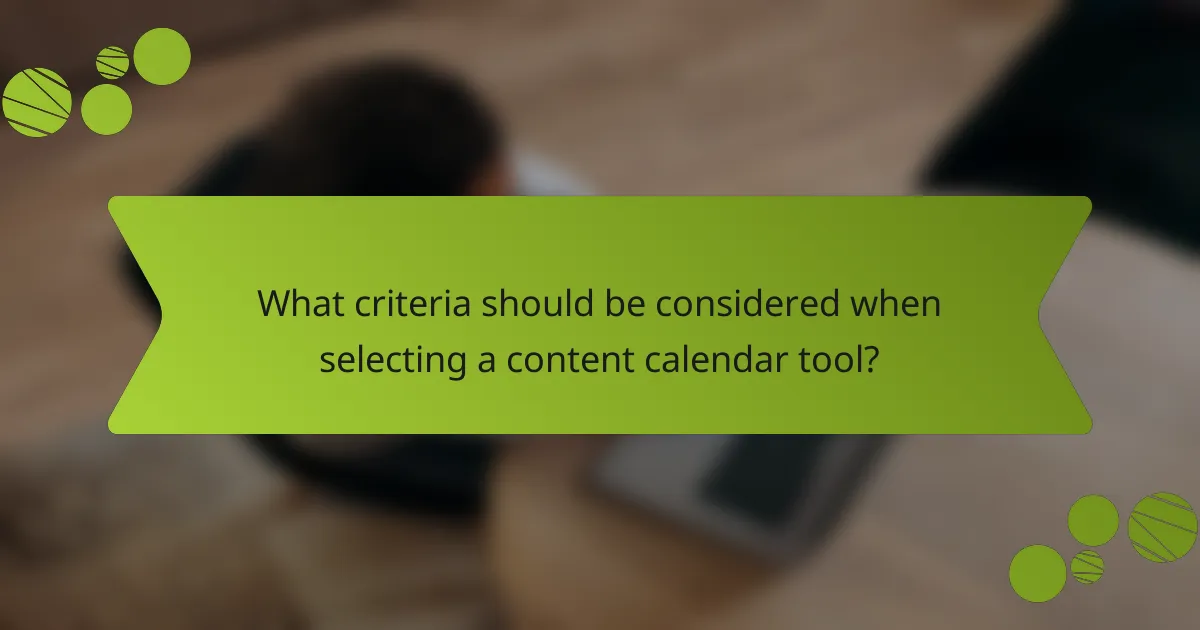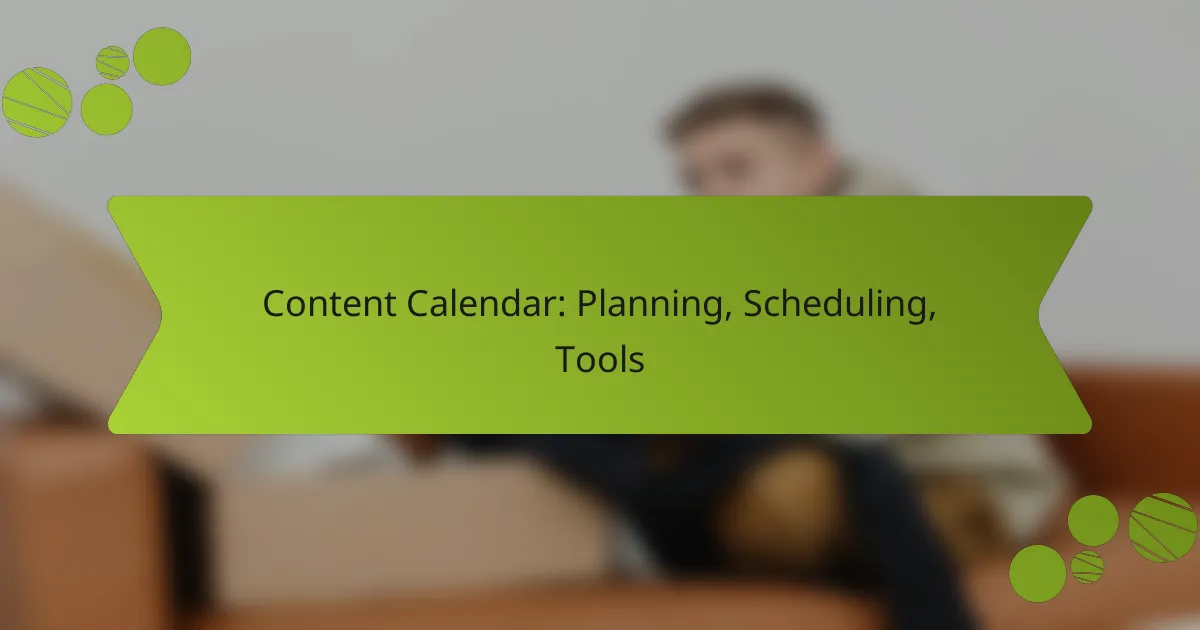A content calendar is an essential tool for planning, organizing, and scheduling your content across various platforms, ensuring that your marketing efforts remain consistent and aligned with your goals. By utilizing effective scheduling strategies and leveraging tools like Trello, Asana, and Google Calendar, you can optimize your content management process and enhance audience engagement.

How to create an effective content calendar?
An effective content calendar is a strategic tool that helps you plan, organize, and schedule your content across various platforms. It ensures consistency and alignment with your marketing goals while allowing for flexibility in response to trends or audience feedback.
Define content goals
Start by clearly defining your content goals, which could range from increasing brand awareness to generating leads or boosting engagement. Specific goals help in shaping the type of content you create and the metrics you will use to measure success.
Consider using the SMART criteria—Specific, Measurable, Achievable, Relevant, and Time-bound—to refine your objectives. For instance, a goal could be to increase website traffic by 20% over the next quarter through targeted blog posts and social media updates.
Identify target audience
Understanding your target audience is crucial for creating relevant content. Identify demographics such as age, gender, location, and interests to tailor your messaging effectively.
Utilize tools like surveys, social media analytics, and customer feedback to gather insights about your audience. This information will inform your content topics and formats, ensuring they resonate with your intended readers.
Choose content types
Selecting the right content types is essential for engaging your audience. Common formats include blog posts, videos, infographics, podcasts, and social media updates, each serving different purposes and audience preferences.
Consider a mix of content types to keep your audience engaged. For example, you might schedule weekly blog posts, monthly webinars, and daily social media updates to create a diverse content experience.
Set a publishing frequency
Establishing a consistent publishing frequency helps maintain audience engagement and builds anticipation. Determine how often you can realistically produce quality content, whether it’s daily, weekly, or monthly.
Be mindful of your resources and audience expectations. For instance, a small business might publish one blog post per week while a larger brand could manage multiple posts daily across various channels.
Utilize templates
Using templates can streamline your content calendar creation process. Templates provide a structured format for planning and scheduling, making it easier to visualize your content strategy.
Consider using spreadsheet tools or dedicated content calendar software that offers customizable templates. This can help you track deadlines, assign tasks, and ensure all content aligns with your overall goals.

What tools can help with content calendar planning?
Several tools can streamline content calendar planning, making it easier to organize, schedule, and manage your content effectively. Popular options include Trello, Asana, Google Calendar, and CoSchedule, each offering unique features tailored to different aspects of content management.
Trello for project management
Trello is a visual project management tool that uses boards, lists, and cards to organize tasks. You can create a board specifically for your content calendar, allowing you to move cards through different stages of the content creation process, from ideation to publication.
To maximize Trello’s effectiveness, consider using labels for content types, due dates for deadlines, and checklists for task completion. This helps keep your team aligned and aware of progress, ensuring that nothing falls through the cracks.
Asana for task tracking
Asana is designed for task tracking and team collaboration, making it suitable for managing content workflows. You can create tasks for each piece of content, assign them to team members, and set due dates to ensure timely delivery.
Utilize Asana’s project templates to quickly set up your content calendar. You can also integrate it with other tools like Google Drive for easy access to documents and files related to your content.
Google Calendar for scheduling
Google Calendar is an excellent tool for scheduling content publication dates and important deadlines. By creating events for each piece of content, you can visualize your publishing schedule and set reminders to keep your team on track.
To enhance collaboration, share your calendar with team members and color-code events based on content type or priority. This ensures everyone is aware of upcoming deadlines and can plan their work accordingly.
CoSchedule for marketing automation
CoSchedule is a comprehensive marketing automation tool that includes a content calendar feature. It allows you to plan, publish, and promote your content all in one place, integrating with popular platforms like WordPress and social media channels.
With CoSchedule, you can automate social media sharing for your content, saving time and increasing visibility. Additionally, its analytics features help you track performance, allowing for data-driven adjustments to your content strategy.

How to schedule content effectively?
Effective content scheduling involves strategically planning when and how to publish your material to maximize engagement and reach. This requires a clear understanding of your audience, the timing of your posts, and the tools available for managing your content calendar.
Use time-blocking techniques
Time-blocking is a method where you allocate specific blocks of time for different tasks, including content creation and scheduling. By dedicating uninterrupted periods to focus solely on content, you can enhance productivity and ensure that your posts are well-prepared.
To implement time-blocking, start by identifying your most productive hours and assign them to content-related tasks. For example, you might reserve mornings for writing and afternoons for editing and scheduling. This structured approach can help prevent distractions and improve the quality of your output.
Prioritize high-impact content
Identifying and prioritizing high-impact content is crucial for effective scheduling. Focus on topics that resonate with your audience and align with your business goals, as these will likely yield the best engagement and conversion rates.
Consider using a scoring system to evaluate potential content ideas based on factors like relevance, audience interest, and potential reach. High-impact content should be scheduled during peak engagement times, which can vary based on your audience’s habits and the platforms you use.
Incorporate seasonal trends
Incorporating seasonal trends into your content schedule can significantly enhance relevance and engagement. This involves planning content around holidays, events, or seasonal changes that are pertinent to your audience.
To effectively leverage seasonal trends, research upcoming events and create a content calendar that aligns with these dates. For instance, if you run a retail business, consider scheduling promotional content around major shopping holidays like Black Friday or Christmas. This approach not only keeps your content timely but also positions your brand as relevant and engaged with current events.

What are the benefits of using a content calendar?
A content calendar offers several advantages, including better planning, streamlined workflows, and improved content quality. By organizing your content strategy, you can ensure timely delivery and alignment with business goals.
Improved organization
A content calendar helps you maintain a structured approach to content creation and publication. By laying out your topics, deadlines, and formats in advance, you reduce the chances of last-minute scrambles and missed opportunities.
Consider using a digital tool or spreadsheet to visualize your calendar. This allows you to easily track progress and make adjustments as needed, ensuring that all team members are on the same page.
Enhanced collaboration
With a content calendar, team members can collaborate more effectively. Everyone involved in the content creation process can see upcoming deadlines and responsibilities, which fosters accountability and reduces confusion.
Utilizing shared platforms like Google Calendar or project management tools can facilitate communication. This way, writers, editors, and designers can provide input and feedback directly within the context of the calendar.
Consistent publishing
Consistency is key in content marketing, and a content calendar helps you maintain a regular publishing schedule. By planning your content in advance, you can ensure that you are consistently delivering value to your audience.
Set a realistic publishing frequency based on your resources, whether it’s weekly, bi-weekly, or monthly. This helps build audience expectations and engagement over time, leading to better results in your content strategy.

What criteria should be considered when selecting a content calendar tool?
When selecting a content calendar tool, consider factors like user interface, integration capabilities, and cost. These criteria will help ensure the tool meets your needs for effective planning and scheduling of content.
User interface and ease of use
The user interface should be intuitive and easy to navigate. A clean layout with drag-and-drop functionality can enhance usability, allowing team members to quickly add or rearrange content. Look for tools that offer customizable views, such as weekly or monthly layouts, to suit your workflow.
Consider the learning curve as well; tools with a simpler interface often require less training and can be adopted more swiftly by your team. Read user reviews to gauge how others perceive the ease of use for different tools.
Integration capabilities
Integration capabilities are crucial for a content calendar tool to work seamlessly with your existing systems. Check if the tool can connect with platforms like social media, email marketing, and project management software. This connectivity can streamline your workflow and reduce manual data entry.
Evaluate the number of integrations offered and whether they align with your current tech stack. A tool that integrates well can save time and enhance collaboration across teams.
Cost and subscription models
Cost is a significant factor when selecting a content calendar tool, as prices can vary widely based on features and subscription models. Some tools offer free versions with limited functionality, while others may charge monthly or annual fees ranging from low tens to several hundred dollars per month.
Consider your budget and the specific features you need. Look for tools that offer tiered pricing, allowing you to scale up as your needs grow. Always check for hidden costs, such as fees for additional users or premium features.









